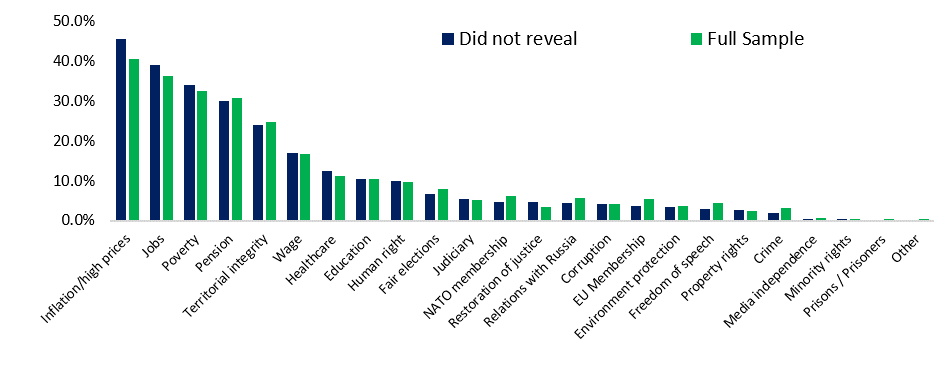Public Opinion Polls: Opportunity for Political Parties

photo credit: Piece of mind. Arithmedes
In early February 2023, the National Democratic Institute (NDI) released findings of the most recent public opinion polls. Among other things, the results reflect that although authorities are responsible for most of the concerns identified by the polling, political parties, particularly those in the opposition, find themselves in unpropitious circumstances. The survey findings also indicate that the top national concerns for the population are rising prices (39.0%), jobs (38.0%) and poverty (30%).
In the political component of the survey, carried out for NDI by the Caucasus Research Resource Centre (CRRC), a central question for the political parties and other respondents was which political party was closest to the voters. However, some 55.5% of the respondents did not name a specific party for three different reasons at the question “which political party is closest to you?” (According to the survey carried out in July-August 2022, such respondents constituted 46.0% of those surveyed). In particular, 38.0% of the respondents say there is no such party, and 10.8% refused to answer, whereas 6.7% do not know which party is closest to them (see Graph 1).
Only 44.5% of those surveyed named a party they believe is closest to them. At the same time, 26.0% of such political party is the ruling Georgian Dream, whereas 6.3% of the respondents believe the opposition United National Movement, with the biggest number of parliamentary seats among the opposition, is closest to them. In the case of other parties, this figure does not exceed 2.0%. Compared to July-August 2022 survey results, December findings show fewer people believe any active political party is closest to them (see Graph 1). This illustrates that situation has worsened for the ruling party, but the opposition parties find themselves in a real predicament. This is alarming for the opposition, particularly given the most concerning issues for the population according to the survey. These issues fall under the government’s scope, and authorities are responsible for addressing them and mitigating problems.
Given all those mentioned above, it is interesting to look at the distribution of respondents who have not named a specific party closest to them based on their different characteristics. It is also interesting to discuss the resources of the ruling party or the opposition to attract potential voters in this population segment. It is possible to measure by using a proxy variable. In particular, this implies a qualitative assessment of the government’s job performance by the same respondents. CRRC’s publicly available databases allow us to make such an assessment.
According to December 2022 survey findings, 49.9% of respondents who believe there is no party closest to them also disapprove of the government’s job performance. Some 35.9% of the same segment positively assesses the government’s job performance (see Graph 2). Around 53.7% of those respondents who refuse to disclose party preferences positively appraise government job performance, as opposed to 34.2% who believe the government’s job performance is bad (see Graph 3). In addition, 54.8% of those who say they do not know which party is closest to them positively assess the government’s job performance, and only 24.4% think that the government is not doing a good job (see Graph 4).
Ultimately, 55.5% of those surveyed do not name a specific political party closest to them. At the same time, 43.8% of such respondents believe that the government’s job performance is bad, whereas 41.6% say it is bad (see Graph 5). Therefore, the opposition and the ruling party have nearly equal capability to attract potential voters. The opposition has the biggest opportunity in a segment where voters say no party is closest to them.
The share of those people who believe that none of the parties is closest to their values and negatively assess the government’s job performance is growing parallel with age. In age distribution, 77.5% are 35 or older, whereas 47.0% are 55 years of age and over (see Graph 6). Regarding geographic distribution, such people reside mostly in rural settlements (see Graph 7).
Those respondents who believe no party is closest to them simultaneously say that the macroeconomic situation is among the most important national issues. In particular, 45.5% of that group believe that rising prices are the biggest problem. This is even higher than the total sample’s figure because, in this case, 39.0% believe that rising prices are the most important national issue. In the case of jobs, these figures are the same, whereas there is a slight difference in the poverty part. Of that part of the population who believes that there is no party closest to them, 38.9% say that jobs are among the top three national issues, whereas 34.0% is poverty (see Graph 8). However, those respondents who negatively assess the government’s job performance underline these issues more clearly. Therefore, this population segment is more concerned about rising prices than the total population.
Generally, the population’s broadly expressed concern vis-à-vis rising prices is unsurprising because since as early as 2019, there has been a 46-month-long period when consumer price growth exceeded the target figure (3%). Moreover, there was a double-digit annual price growth rate for 17 consecutive months. In turn, changes in the general level of prices bring arbitrary redistribution effects among individuals. In particular, redistribution happens from a relatively poorer majority for the benefit of the wealthier minority. Nevertheless, this issue was not high on the political agenda of the opposition parties. Rising prices were not in the ruling party’s spotlight either, but on the contrary, the ruling party and government sought to shift focus on double-digit economic growth.
Ultimately, National Democratic Institute’s (NDI) public opinion poll findings show that the population has increased concerns over rising prices and jobs. At the same time, that group of people who say no party is closest to them is more vocal in expressing their concern about rising prices than the total survey population. This is indicative that concerns identified by the population, such as rising prices, jobs, poverty and other pressing issues, as well as alternatives for their solution, are insufficiently represented in the political agenda of rival political parties.
On the other hand, the opposition political parties have more opportunities to increase support from a segment of people who do not believe any party is closest to them. This is because the plurality of those people (49.9%) neither likes the government policy nor sees satisfactory results of that policy to overcome the problems they face. Therefore, the opposition political parties must modify their political agenda to use this opportunity. In particular, this can push forward the rising prices, jobs and other economic problems among political issues and offer credible solutions.
Graphs:
Graph 1: Question – Which political party is closest to you?

Source: Caucasus Research Resource Centre
Graph 2: Group – No party closest to them: Government job appraisal

Source: Caucasus Research Resource Centre
Graph 3: Group – Did not disclose the political party closest to them: Government job appraisal

Source: Caucasus Research Resource Centre
Graph 4: Group – Did not know the political party closest to them: Government job appraisal

Source: Caucasus Research Resource Centre
Graph 5: Group – Refused to name political party closest to them: Government job appraisal

Source: Caucasus Research Resource Centre
Graph 6: Group – Did not / could not name the political party closest to them: Age distribution

Source: Caucasus Research Resource Centre
Graph 7: Group – Did not / could not name the political party closest to them: geographic distribution

Source: Caucasus Research Resource Centre
Graph 8: Group - Did not/could not name the political party closest to them and full sample: the most important national issues

Source: Caucasus Research Resource Centre

